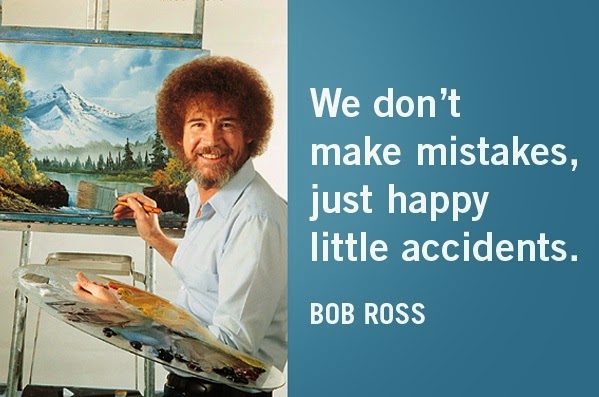by Elizabeth Van Allen for scribblesbyartteachervanallen.blogspot.com
 |
| It takes a very special person to be able to look through a TV camera straight into the hearts and minds of millions and connect with them on the level that Bob Ross did. That man was hypnotic. |
Thanks to dollar stores and the internet, these days almost everyone has access to at least the most basic of supplies and instruction. Yet even with the luxury of accessibility that we now enjoy, there are still so many who don't or won't take a chance on themselves and just create. In my expert opinion, there is one giant, glittery elephant in the room that keeps most people from expressing themselves through art: the preconceived notion that only those deemed as 'artists' can or should make art. That's where the magic that was Bob Ross comes in.
So who was BOB ROSS?
Here's the reader's digest version:
- Before painting, he had a 20-year career in the air force and retired at the rank of Master Sergeant
- He was a lover of wildlife and often cared for baby, injured, and abandoned animals- especially squirrels
- He hosted the The Joy of Painting on PBS from 1983-1994 (USA)
- Bob used a rapid painting technique called wet-on-wet (also called alla prima) in which paint layers are applied directly onto other wet layers and color is blended directly on the canvas. Side note: Painting in this way is very easy to learn and satisfying to use, but traditionally it is often looked down on by the larger art community. In my opinion, this is partially due to it's ease of use. In comparison to other painting techniques it takes very little training to produce a pretty picture, and is sometimes seen as a cheat or a shortcut with little actual content or merit as a professional technique.
- He used the wet-on-wet technique because it allowed him to teach some basic painting skill to anyone who wanted to learn. This made it possible for him to do a complete painting from start to finish in a mere 28 minutes per episode.
- Bob Ross painted because it made him happy. He taught painting to bring more happiness into the lives of others.
 |
| This painting is by Franz Hals, a 16th century Flemish master and pioneer of the alla prima technique. Learn more at http://www.explore-drawing- and-painting.com/oil-painting-technique.html |
Somewhere in the tiny part of my brain that is reserved for art snobbery, I keep hearing a disturbing whisper. "You shouldn't like his work", it whispers. "his painting is sentimental fluff without purpose or message". It's a good thing that I have a much larger section
 |
| Watch Bob Ross feed a baby squirrel at https://www.youtube.com/watch?v=-YmIpZ8iius pic from http://www.huffingtonpost.com/2012/10/ 17/bob-ross-feeds-a-baby-squ_n_1970322.html |
"BESIDES," it bellows, "HOW COULD YOU POSSIBLY DISLIKE A MAN WHO TOOK THE TIME TO BOTTLE-FEED ORPHANED BABY SQUIRRELS? HAVE YOU NO SOUL?"
And so, as I reflect on my (possibly unhealthy) dedication to a true cultural icon,
I would like to express my feelings in verse.
Bob Ross: the Haiku
The joy of painting
Hypnotizing voice and hair
Happy little trees
Bob Ross: the Limerick
Bob Ross was an oil landscape painter
who said "be happy" to the haters.
With hair worn in curls,
he bottle-fed squirrels
and inspired generations of art makers.
Is there someone who had
a profound effect on your
philosophy and/or art?
a profound effect on your
philosophy and/or art?
Leave a comment and tell us how!



No comments:
Post a Comment